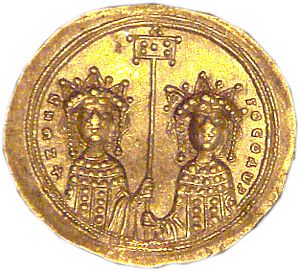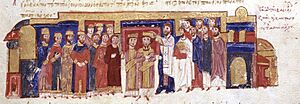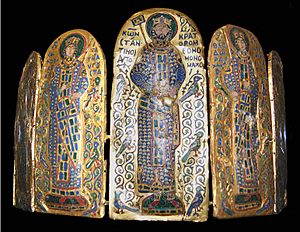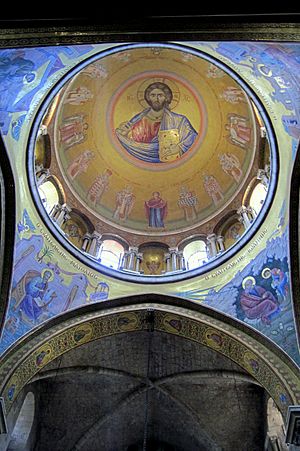Constantine IX Monomachos facts for kids
Quick facts for kids Constantine IX Monomachos |
|
|---|---|
| Emperor and Autocrat of the Romans | |
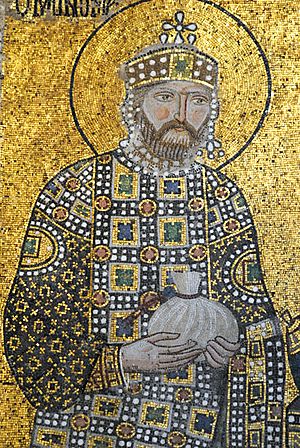
Mosaic of Emperor Constantine IX at the Hagia Sophia.
|
|
| Byzantine emperor | |
| Reign | 11 June 1042 – 11 January 1055 |
| Coronation | 12 June 1042 |
| Predecessor | Zoë and Theodora |
| Successor | Theodora |
| Co-rulers | Zoë (1042–1050) Theodora (1042–1055) |
| Born | c. 1000/1004 Antioch |
| Died | 11 January 1055 (aged 50–55) Constantinople |
| Burial | Monastery of Mangana, Constantinople |
| Spouse | Maria Skleraina Zoë Porphyrogenita |
| Issue | Anastasia of Byzantium |
| Dynasty | Macedonian |
| Father | Theodosios Monomachos |
Constantine IX Monomachos (Medieval Greek: Κωνσταντῖνος Μονομάχος, romanized: Kōnstantinos IX Monomachos; around 1004 – 11 January 1055) was a Byzantine emperor. He ruled from June 1042 until January 1055. Empress Zoë Porphyrogenita chose him to be her husband and co-emperor in 1042. This happened even though he had been sent away for plotting against her previous husband.
Constantine shared the throne with Empress Zoë and her sister Theodora Porphyrogenita. Zoë passed away in 1050. Constantine then continued to rule with Theodora until he died five years later.
During his rule, Constantine fought wars against different groups. These included the Kievan Rus', the Pechenegs, and the rising Seljuq Turks in the East. Even with these challenges, the Byzantine Empire mostly kept its borders. It even grew a bit to the east by taking over the rich Armenian kingdom of Ani. Because of this, Constantine is seen as the last strong emperor of the Byzantine Empire's golden age.
A year before he died, in 1054, a big split happened in the Christian church. This event is known as the Great Schism. It divided the Eastern Orthodox and Roman Catholic churches. Constantine knew this split would have major effects. He tried to stop it, but his efforts were not successful.
Contents
Early Life of Constantine IX
Constantine Monomachos was the son of Theodosios Monomachos. His father was an important official under earlier emperors. Constantine was part of the well-known and noble Monomachos family. He was born around 1000-1004 in Antioch. People at the time said he was "a marvel of beauty."
Constantine's father was once suspected of plotting against the emperor. This made it hard for Constantine to advance in his career. His situation improved after he married his second wife. She was a niece of Emperor Romanos III Argyros. Later, Empress Zoë Porphyrogenita noticed him. However, her second husband, Emperor Michael IV, sent Constantine away to the island of Lesbos.
After Emperor Michael IV died, Constantine was called back in 1042. He was supposed to become a judge in Greece. But before he could start, he was called to Constantinople. The two empresses, Zoë and Theodora Porphyrogenita, were not getting along. After two months of disagreements, Zoë decided to find a new husband. She hoped this would stop her sister from gaining more power.
Zoë's first choice for a husband was disrespectful. Her second choice died mysteriously. Then, Zoë remembered the handsome Constantine. They were married on June 11. The church leader, Patriarch Alexius of Constantinople, did not perform the ceremony. He refused to be part of a third marriage for both of them. Constantine was crowned emperor the very next day.
Constantine IX's Time as Emperor
When Constantine became emperor, he removed relatives of the previous emperor from the court. He enjoyed a life of luxury. He could also become angry if he suspected someone was plotting against him. He was greatly influenced by his close companion, Maria Skleraina, and her family.
In August 1042, Constantine removed a general named George Maniakes from his command in Italy. Maniakes then rebelled and declared himself emperor. He moved his soldiers into the Balkans. He was about to defeat Constantine's army when he was wounded and died. This ended the rebellion in 1043.
Right after this victory, Constantine's empire was attacked by a fleet from Kievan Rus'. They were also defeated, partly with the help of "Greek fire". To make peace, Constantine arranged for his daughter Anastasia to marry Vsevolod I of Kiev. Vsevolod was the son of the Rus' leader, Yaroslav I the Wise. Constantine's family name, Monomachos, means "one who fights alone." This name was passed down to Vsevolod and Anastasia's son, Vladimir II Monomakh.
Early in his reign, Constantine showed special favor to Maria Skleraina. This led to rumors that she planned to harm Empresses Zoë and Theodora. In 1044, the people of Constantinople rebelled. The uprising was dangerous for Constantine as he was in a religious parade. The crowd only calmed down when Zoë and Theodora appeared on a balcony. They assured the people that they were safe.
In 1045, Constantine added the Armenian kingdom of Ani to the empire. But this expansion also brought new enemies. In 1046, the Byzantines met the Seljuk Turks for the first time. They fought in Armenia in 1048 and agreed to a truce the next year. Even if the Seljuk leaders wanted peace, their allies often caused trouble. The Byzantine forces would later suffer a huge defeat at the battle of Manzikert in 1071. Constantine also tried to unite the Armenian Church with the Orthodox Church. In 1046, he reopened the University of Constantinople. He created departments for Law and Philosophy.
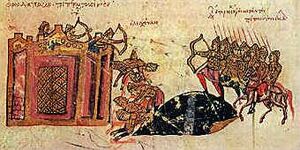
In 1047, Constantine faced a rebellion from his nephew, Leo Tornikios. Tornikios gathered supporters and was declared emperor by the army. Tornikios was forced to retreat. He failed in another attack and was captured while trying to escape. This revolt weakened the empire's defenses in the Balkans. In 1048, the area was raided by the Pechenegs. They continued to plunder for five years. The emperor tried to use diplomacy to stop them. But this only made things worse. Rival Pecheneg leaders fought on Byzantine land. Pecheneg settlers were allowed to live in the Balkans, making it hard to stop their rebellion.
Constantine used a system called pronoia. This was a bit like a feudal contract. Land or tax money was given to individuals. In return, they had to help maintain military forces. Constantine could spend a lot of money from the imperial treasury. Once, he reportedly sent an Arab leader 500,000 gold coins. That's more than two tons of gold!
In 1054, long-standing differences between the Eastern and Western churches led to their final split. This was the Great Schism. Representatives from Pope Leo IX removed the Patriarch of Constantinople, Michael Keroularios, from the church. This happened because Keroularios would not accept Western church practices. In return, Keroularios removed the Pope's representatives from the church. This ruined Constantine's plans to ally with the Pope against the Normans. The Normans had taken over Southern Italy after General Maniakes disappeared.
Constantine tried to help, but he became ill. He died on January 11 of the next year. His advisors convinced him to ignore the rights of the elderly Theodora. They wanted him to give the throne to Nikephoros Proteuon. However, Theodora was called back from her retirement and became empress.
Architecture and Art
A famous writer and historian named Michael Psellos was part of Constantine IX's court. His book, Chronographia, tells the story of Constantine's rule.
Right after becoming emperor in 1042, Constantine IX began restoring the Church of the Holy Sepulchre in Jerusalem. This church had been largely destroyed in 1009. An earlier emperor had secured the right to rebuild it. But it was Constantine who finally started the project. He paid for the reconstruction of the Church and other Christian buildings in the Holy Land.
See also
 In Spanish: Constantino IX para niños
In Spanish: Constantino IX para niños
Sources
Primary sources
- Michael Psellus, Fourteen Byzantine Rulers, trans. E.R.A. Sewter (Penguin, 1966). ISBN: 0-14-044169-7
- Thurn, Hans, ed. (1973). Ioannis Scylitzae Synopsis historiarum. Berlin-New York: De Gruyter. ISBN 9783110022858. https://books.google.com/books?id=79jH-QXdf0EC.
Secondary sources
- Blaum, Paul A. (2004). "Diplomacy Gone to Seed: A History of Byzantine Foreign Relations, A.D. 1047-57". International Journal of Kurdish Studies 18 (1): 1–56.
- Bréhier, Louis (1946) (in fr). Le monde byzantin: Vie et mort de Byzance. Paris, France: Éditions Albin Michel. OCLC 490176081. http://classiques.uqac.ca/classiques/brehier_louis/monde_byzantin/brehier_vie_et_mort_byzance.pdf.
- Kaldellis, Anthony (2017). Streams of Gold, Rivers of Blood: The Rise and Fall of Byzantium, 955 A.D. to the First Crusade. New York: Oxford University Press. ISBN 978-0-1902-5322-6. https://books.google.com/books?id=TmzJDgAAQBAJ.
- Jeffreys, Michael, ed. (2016). "Konstantinos IX Monomachos". Prosopography of the Byzantine World. King's College London. ISBN 978-1-908951-20-5. https://pbw2016.kdl.kcl.ac.uk/person/Konstantinos/9/.
- Laiou, Angeliki E (2002). Economic History of Byzantium. Washington, D.C.: Dumbarton Oaks. ISBN 0-88402-288-9.
- Angold, Michael. The Byzantine empire 1025–1204 (Longman, 2nd edition, 1997). ISBN: 0-582-29468-1
- Harris, Jonathan. Constantinople: Capital of Byzantium (Hambledon/Continuum, 2007). ISBN: 978-1-84725-179-4
- Finlay, George. History of the Byzantine Empire from 716 – 1057, William Blackwood & Sons, 1853.
- Garland, Lynda. Conformity and Non-conformity in Byzantium, Verlag Adolf M. Hakkert, 1997. ISBN: 978-9-02560-619-0
|
Constantine IX Monomachos
Born: c. 1006 Died: 11 January 1055 |
||
| Regnal titles | ||
|---|---|---|
| Preceded by Zoë Porphyrogenita and Theodora Porphyrogenita |
Byzantine emperor 1042–1055 with Zoë (1042-1050) and Theodora (1042-1055) |
Succeeded by Theodora Porphyrogenita |


